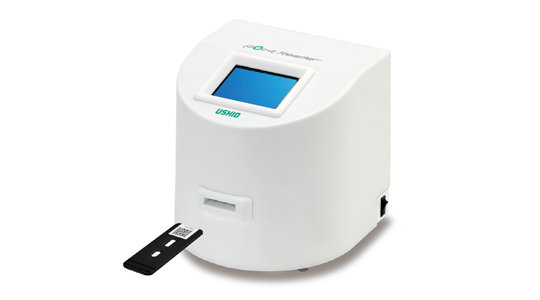Japan's First Quantitative Assay of Serum Ferittin Based on Immunochromatography Commencement of Domestic Sale of Point Reader® Blood Analyzer and Corresponding Reagents
For full-scale entry into optical diagnostics market
with more measurement items
USHIO INC. (headquarters: Tokyo, Japan; President and Chief Executive Officer: Shiro Sugata; hereinafter “USHIO”) today announced that it will launch the new Point Reader®, a tabletop blood analyzer that employs immunochromatography(*1), in Japan. Point Reader® will be brought out along with Point Strip® Ferittin, a series of special serum ferittin(*2) reagents, via Nipro Corporation (headquarters: Osaka, Japan; President: Yoshihiko Sano) on April 22, 2013.
This represents Japan’s first commercialization(*3) of the device and reagents that enable quantification of serum ferittin by immunochromatography.
Quantitative measurements of serum ferittin were only possible at certain facilities and institutes before the advent of the device and reagents. Point Reader® and Point Strip® Ferittin allow doctor’s offices and clinics to perform such measurements precisely, conveniently and promptly, and also alleviate burden on patients and medical professionals during examination.
Starting via the launch of the device and reagents, USHIO will enter the optical diagnostics market at full scale and sequentially market special reagents (for visceral diseases and the myocardial system) that meet needs of clinical sites.

This product will not be distributed for overseas use because it has only acquired approval for marketing in Japan (for more details, please contact us).
|
*1 Immunochromatography refers to immunoassay based on the capillary phenomenon. When a sample is dropped in a reagent, an antigen from the sample will develop color through combination (formation of complex) with antibody (labeled antibody such as gold colloid) that is incorporated in a reagent beforehand. The color development of individual complexes is not visible. However, if complexes get together, the color development will become visible to the unaided human eye. This permits judgment on whether there are any antigens in a sample. Uses of conventional immunochromatography were limited to qualitative measurements for influenza, pregnancy and allergies because of the low precision of quantification despite the easy handling. *2 Ferittin is the protein that stores iron. The level of serum ferittin fluctuates, reflecting the amount of iron stored within the body. The quantitative analysis of serum ferittin is commonly required as it helps examination, diagnosis and understanding of pathology prior to phlebotomy for iron-deficiency anemia, iron overload disorder, leukemia and chronic hepatitis C. *3 Surveyed by USHIO, as of March 31, 2013 |
Background of development
Serum ferittin is currently measured at about 30,000 institutes in Japan. Only a limited number of these institutes own expensive, large, automated analyzers for quantitative assay. It is not unusual to find that institutes outsource measurements due to such issues as the number of measurements and cost even if they own an analyzer.
Under such circumstances, it usually takes several days until assay results are revealed, and there were some problems noted such as handling of high-urgency patients and the need for more frequent hospital visits by patients requiring regular treatment and examinations. Accordingly, there was demand for a device that permits quantitative analysis in clinical practice.
Quantitative assay of serum ferittin through immunochromatography
The Point Reader® blood analyzer and Point Strip® Ferittin series of special reagents employ immunochromatography, which is effective for device downsizing, shortened analysis time, and facilitation of operation and maintenance.
USHIO has dramatically improved analytical capabilities based on immunochromatography by analyzing the delicate shading of colors appearing in accordance with the concentration of serum ferittin in the sample, using its unique optical technology and algorithm. Moreover, temperature dependency, i.e., disadvantage of immunochromatography, has been drastically improved through the employment of a unique structure that considers effects of changes in ambient temperature on measurements.
The result is favorable correlation in performance of the analyzer and the reagents with large, automated analyzers. This for the first time enables quantitative analysis of serum ferittin at clinical sites.
Future developments
The Point Reader® blood analyzer enables analysis of many different measurement items when different special Point Strip® reagents are used. USHIO has already commenced development of varied reagents that satisfy medical needs such as visceral diseases and the myocardial system, which will follow serum ferittin that is to be released. New reagents will be launched sequentially to strengthen the Point Strip® series.
Under close cooperation with clinical sites, as a manufacturer specializing in optics, USHIO will continue to solve technical issues that medical fields face and also provide optical medical devices and services to realize healthcare oriented to quality-of-life (QOL), that reduces pain and burden for patients during treatment and examination.
About Nipro Corporation (headquarters: Osaka, Japan; TSE/OSE: 8086)
Established in 1954. Nipro Corporation focuses on the research and development, production and distribution of medical device, pharmaceuticals and glass instruments. The product portfolio of the medical device section incorporates artificial organ products including dialyzers (artificial kidney dialysis devices), artificial hearts and lungs; injection/infusion products including needles and catheters; cardiovascular products used for endovascular treatment; examination/diagnostic drug products including blood sugar measuring devices, blood collection tubes and diagnostic drugs; and cellular cultivation products such as incubation bags. In the pharmaceutical section, it handles injection product kits, powdered agents of dialysis solutions, and other agents for oral/external use. The glass section includes glass products for medical use such as ampules and vials, and glass equipment such as vacuum flasks.
http://www.nipro.co.jp
